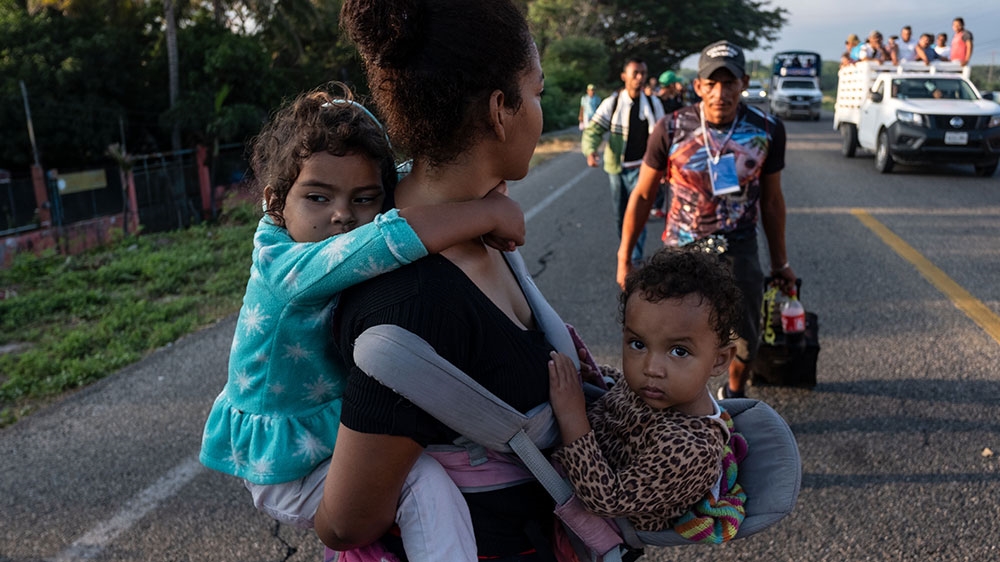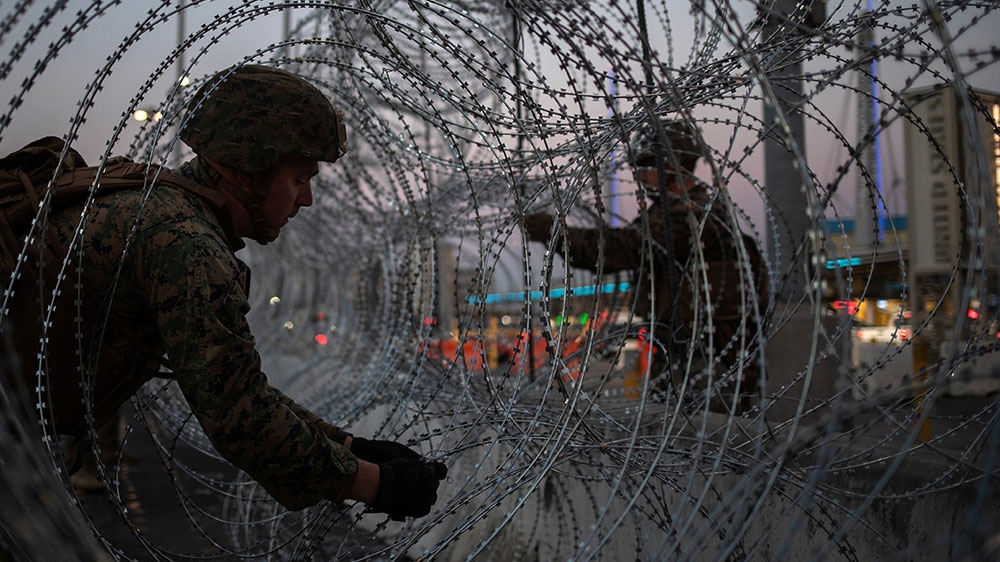More asylum seekers arrive at border as US expands military power
Tijuana, Mexico – Miriam* reported the death threats to the Honduran police. Twice. And she took her nephew to the medical examiner after gang members attacked him.
“I was taking care of one of my nephews and the gang wanted me to hand him over. They wanted to recruit him,” Miriam says.
“I refused, and that is when they wanted to harm us. You don’t refuse them anything they ask, because they will kill you. I went to file reports with the police and it was useless,” she tells Al Jazeera.
The Honduran police did nothing and a representative from the governmental human rights commission told her the family should flee for safety, Miriam says. She called her sister, who came home immediately. The sisters, Miriam’s husband, her three children and 14-year-old nephew all left La Ceiba on the same day in September.
Her sister and nephew fled their home in northern Honduras to Europe and Mariam and her family fled to Mexico.
Their first stop was in Tapachula, where Mariam’s family applied for humanitarian visas. When a caravan of several thousand migrants and refugees, who undertook a collective month-long journey north through Guatemala and Mexico, passed through the city, they wanted to join but decided to stay behind in order to ensure they would receive the visas.
But this week, the 30-year-old and her family caught up with the collective exodus in Tijuana where they are now staying until they can apply for asylum.
The wait could be weeks, however, as the Trump administration continues to try to put restrictions on the group and the thousands more that follow behind.
Rights groups challenge asylum rules
Earlier this month, President Donald Trump declared that asylum claims would only be processed if those making them crossed into the US at official ports of entry.
A district court in California struck down the measure on Monday, issuing a temporary injunction to put an immediate halt to its implementation pending a December 19 hearing.
The lawsuit that may impact Miriam and her family the most, however, is a complaint challenging former Attorney General Jeff Sessions’s June guidance, which makes it harder for individuals fleeing gang violence and domestic abuse to apply asylum.
The lawsuit was filed by the American Civil Liberties Union and the Center for Gender & Refugee Studies in August. Court proceedings are ongoing.
 |
| In this file photo taken on November 1, 2018 migrants and refugees heading to the US, walk along the road from La Ventosa to Matias Romero, Oaxaca State, Mexico [Guillermo Arias/AFP] |
Along with poverty and unemployment, violence is the most common factor driving the exodus.
Mariam continues to hold copies of the medical examiner’s report and the papers she filed with police to show why her family fled. Al Jazeera has interviewed several other individuals and families fleeing gang violence in Honduras and El Salvador.
The Trump administration says the new rules are needed to protect the US and its border. On Tuesday, Kirstjen Nielsen, the Department of Homeland Security secretary, said, without providing evidence, that the the US had identified hundreds of criminals, including known gang members, travelling with the caravan.
Expanded military powers
In Tijuana, however, migrants and refugees are more concerned about the potentially armed and dangerous forces north of the border.
Separately on Tuesday, White House Chief of Staff John Kelly reportedly signed a memo authorising military personnel to perform activities deemed “reasonably necessary” to protect US border agents, including “a show or use of force (including lethal force, where necessary), crowd control, temporary detention, and cursory search”.
“I now have the authority to do more,” Department of Defense Secretary Jim Mattis told reporters on Wednesday.
“If I change the mission then something like that could happen,” he said, adding there is not intention to do so now but that the situation depends on directives from Nielsen.
 |
| United States Marines fortify concertina wire along the San Ysidro Port of Entry border crossing as seen from Tijuana [Adrees Latif/Reuters] |
More than 5,000 active duty troops are deployed in border areas. Military officials declared they will be home in time for the December holidays, but Mattis is not ruling out an extension or new missions, he said.
Around that same time, the Central American migrants and refugees will likely only be beginning to cross from Mexico into the United States. US officials have drastically limited the number of asylum claims processed per day at ports of entry this year, and there is a long waiting list at the San Ysidro crossing in Tijuana.
Miriam and her family put their names down on the waiting list as soon as they arrived in Tijuana last week. She was told to return in three weeks to check and see if their numbers would be coming up soon, but several asylum seekers who arrived before the Central American exodus told Al Jazeera they had already been waiting for three to four weeks and their numbers were still a ways off.
Miriam is not concerned. She and her family waited more than six weeks in Tapachula before receiving their humanitarian visas, and they are prepared to wait their turn to continue north and request asylum in the US, where she and her husband both have relatives. Still, it is not the future they had ever envisioned, she says.
“We had never dreamed of leaving Honduras,” she says. “We were forced to make the decision.”
*Al Jazeera has changed the individual’s name to protect her identity at her request.




